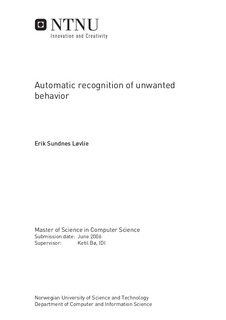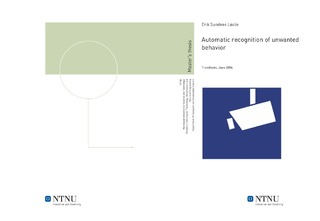| dc.contributor.advisor | Bø, Ketil | nb_NO |
| dc.contributor.author | Løvlie, Erik Sundnes | nb_NO |
| dc.date.accessioned | 2014-12-19T13:34:36Z | |
| dc.date.available | 2014-12-19T13:34:36Z | |
| dc.date.created | 2010-09-05 | nb_NO |
| dc.date.issued | 2006 | nb_NO |
| dc.identifier | 349083 | nb_NO |
| dc.identifier | ntnudaim:1126 | nb_NO |
| dc.identifier.uri | http://hdl.handle.net/11250/251586 | |
| dc.description.abstract | The use of video surveillance in public areas is ever increasing. With that increase, it becomes impractical to continue using humans to view and respond to the surveillance video streams, due to the massive amount of information that must be processed. If one hope to use surveillance to avoid personal injuries, damage to property and so forth, instead of merely a forensic tool after the fact, humans must be replaced by artificial intelligence. This thesis examines the whole process of recognizing unwanted human behaviors from videos taken by surveillance cameras. An overview of the state of the art in automated security and human behavior recognition is given. Algorithms for motion detection and tracking are described and implemented. The motion detection algorithm uses background subtraction, and can deal with large amounts of random noise. It also detects and removes cast shadows. The tracking algorithm uses a spatial occupancy overlap test between the predicted positions of tracked objects and current foreground blobs. Merges/splits are handled by grouping/ungrouping objects and recovering the trajectory using distance between predicted position and foreground blobs. Behaviors that are unwanted in most public areas are discussed, and a set of such concrete behaviors described. New algorithms for recognizing chasing/fleeing scenarios and people lying on the floor are then presented. A real-time intelligent surveillance system capable of recognizing chasing/fleeing scenarios and people lying on the floor has been implemented, and results from analyzing real video sequences are presented. The thesis concludes with a discussion on the advantages and disadvantes of the presented algorithms, and suggestions for future research. | nb_NO |
| dc.language | eng | nb_NO |
| dc.publisher | Institutt for datateknikk og informasjonsvitenskap | nb_NO |
| dc.subject | ntnudaim | no_NO |
| dc.subject | SIF2 datateknikk | no_NO |
| dc.subject | Intelligente systemer | no_NO |
| dc.title | Automatic recognition of unwanted behavior | nb_NO |
| dc.type | Master thesis | nb_NO |
| dc.source.pagenumber | 108 | nb_NO |
| dc.contributor.department | Norges teknisk-naturvitenskapelige universitet, Fakultet for informasjonsteknologi, matematikk og elektroteknikk, Institutt for datateknikk og informasjonsvitenskap | nb_NO |

